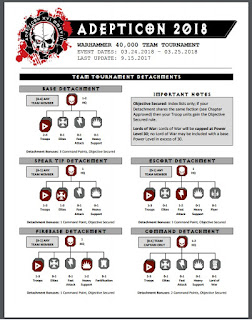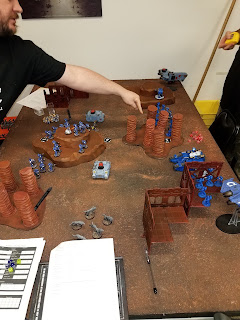Today, my friend Tom and I went to a tournament run by the good guys over at the
Forge World Columbia gaming club and
Mageling Games in Columbia, Missouri. For those new to the tabletop community, most games will have some sort of organized gameplay events, and a lot of the FLGSs (Friendly Local Game Store) will run them with some regularity. A couple of weeks ago, I saw an event pop up, and talked Tom and figured we would go push some plastic army men, chuck dice, and make general fools of ourselves, away from the family for a few hours.
Before I get into the Tournament Review, I want to talk about tournaments and a few pointers. After building your list, checking it twice, making sure your models are ready to go (painted, based, have arms and heads), stop a few minutes and do yourself and the Tournament Organizer (TO) a favor - go back and review the restrictions on the tournament.
There's a story coming up in all of this, I promise. I am, in particular, a Warhammer 40k player, so I will talk about 40k events, but the same can be said of most events of this type. Most events will post the rules and expectations of players, well ahead of time. Currently, the favored tournament formats are Independent Tournament Circuit (ITC events), although run by different groups, will use very similar sets of rule.
Before building your list out, take the time to familiarize yourself with the rules (usually available months in advance) and any army construction restrictions.
And here comes the story. Tom and I laid out a brilliant 2 x 1k point list Chaos army, using Death Guard and Thousand Sons.
We played a test game against 2 1k lists made up of Ultramarines Primaris Marines, and Space Wolves, and determined that for ease of play, so we didn't drive our opponents crazy not fully knowing or remembering our rules, we would use these two armies instead.
We built out our lists, packed up our (okay, my armies, because I am a paint snob) and headed off to the event. Everything was going great, chatting with the guys, hanging out, until we went to list turn in. Had I checked the Adepticon and Event post on Facebook more carefully, I would have known this and been able to build our lists to be correct and LEGAL for the event.

Ben, the TO at the event allowed us to play anyway, and we made sure to inform our opponents. Gratefully, all three sets of our opponents didn't complain about this infraction, and we were allowed to play. In larger events, we would have been DQd and sent packing.
Our Lists for the event were thus:
Ultramarine Strike Force 997 points
+ HQ +
Primaris Librarian [101pts]
Psychic Scourge, Null Zone, Force sword, The Armour Indomitus
+ Elites +
Primaris Apothecary [68pts]
+ Troops +
Intercessor Squad [162pts]: Bolt rifle
8x Intercessor, Intercessor Sergeant
Intercessor Squad [162pts]: Bolt rifle
8x Intercessor, Intercessor Sergeant
+ Flyer +
Xiphon Interceptor [240pts]: 2x Twin lascannon, Xiphon missile battery
+ Heavy Support +
Hellblaster Squad [16 PL, 264pts]: Plasma incinerator
7x Hellblaster, Hellblaster Sergeant
Space Wolf Strike Force 997
+ HQ +
Rune Priest [6 PL, 105pts]: 3. Jaws of the World Wolf, Bolt pistol, Runic armour, Runic staff
Wolf Lord [5 PL, 84pts]: Bolt pistol, Frost axe
+ Fast Attack +
Fenrisian Wolves [2 PL, 30pts]: 5x Fenrisian Wolf
+ Troops +
Blood Claws [8 PL, 159pts]
8x Blood Claw w/Bolt Pistol, Chainsword
Blood Claw Pack Leader: Bolt Pistol, Power fist
Blood Claw with Special Weapon: Meltagun
Grey Hunters [6 PL, 69pts]
Grey Hunter Pack Leader: Power sword
4x Grey Hunter w/Bolt Pistol, Bolter
+ Dedicated Transport +
Razorback [5 PL, 87pts]: Twin heavy bolter
Grey Hunters [6 PL, 69pts]
Grey Hunter Pack Leader: Power sword
4x Grey Hunter w/Bolt Pistol, Bolter
+ Dedicated Transport +
Razorback [5 PL, 114pts]: Twin assault cannon
+ Flyer +
Stormwolf [14 PL, 279pts]
Twin helfrost cannon
Two Lascannons: 2x Lascannon
Two Twin Heavy Bolters: 2x Twin heavy bolter
We went 0-2, first game was close, second was a solid victory, and third was an all out disaster.
I'll compile all the tournament stuff I collected and post again here in a few days. But for now, enjoy some pictures:



























